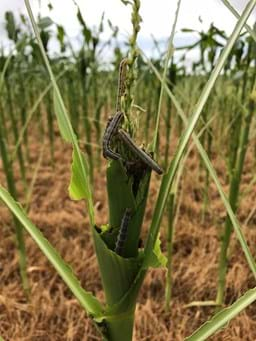Agronomy Update: Agronomy Team Advises Scouting
BY DAIRYLAND SEED AGRONOMY TEAM
Insect Trap Counts Have Been High For Armyworm Recently
Insect pheromone traps are indicating heavy migration of true armyworm. We are getting numerous calls for damage from true armyworm to corn and wheat right now! They have hitched a ride from the southern states by riding on weather systems and getting dumped off to begin their life cycle in the Midwest.
|
True armyworm adults will lay eggs in small grains including cereal rye cover crop. Corn planted into rye cover crop should be scouted regularly for true armyworm feeding. In addition, any corn planted next to rye or wheat should be scouted for true armyworm feeding as the wheat or rye matures. True armyworm will leave maturing wheat or rye and migrate to neighboring corn fields. True armyworm infestations may consume a lot of corn very quickly -- scouting is essential. Meanwhile wheat must be scouted for true armyworm feeding. True armyworm may cause heavy economic damage to wheat also. Six armyworm/foot of row and the larva is less than 1” justifies treatment in wheat. 25 percent feeding damage and the larva are less than 1” with 2 or more larva justifies treatment in corn. Please scout! |
|
Is Red/Purple Corn Still Actively Growing?
In last week’s newsletter, we discussed some of the conditions that could be conducive for causing red/purple colored corn. Basically, red/purple corn may occur based on genetics, anything that restricts or reduces roots, cool weather and phosphorus deficiency. Red/purple corn concerns growers, however it does not necessarily mean it is unhealthy and not doing well if it is red/purple. If phosphorus levels are adequate, compaction is not an issue, insect feeding is not a factor and too much or too little moisture is not an issue, then you most likely don’t have anything to worry about.
In reality, every plant is a solar powered factory that generates energy for plant growth. The energy generated is powered by the sun’s solar spectrum of Red, Orange, Yellow, Green, Blue, Indigo and Violet, (ROYGBIV) wave lengths of light. The same colors in a rainbow. Colored pigments within the chlorophyll molecule that absorb and generate the most energy for plant growth are blues, reds, oranges, yellows.
Green is mostly reflected instead of absorbed for production of energy. We see green plants because it is reflected instead of being absorbed. Meanwhile, the blues, reds, orange and yellow pigments that are within the chlorophyll molecule are absorbing those light waves from the sun and producing energy for the plant, even though we can’t see those colors on plant tissue because they are being absorbed and producing energy and not reflected.
So, when the corn plants are red/purple, the orange, yellow and some of the red and blue pigments are still at work generating energy and contributing to plant growth and development. What a miracle! The definition of photosynthesis is, the process of using solar energy to convert carbon dioxide into sugars that the plant uses for energy to grow and develop. Without it, there would be no life on our planet.
White Mold
As we move into the middle of June and towards the longest day and, subsequently, the shortest night of the year, (Summer Solstice or First Day of Summer) I start looking for flowers on soybean plants. Soybean plants can start the flowering process from V2 -V8 (2nd to 8th Trifoliolate) and with early planting dates can start flowering prior to Summer Solstice.
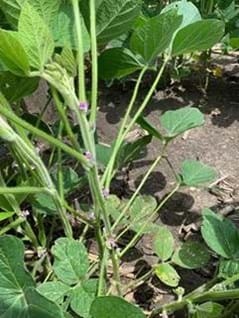 |
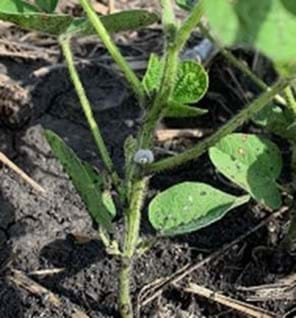 |
Once a soybean plant starts to flower it is in the Reproductive phase or R1 (Beginning Bloom- one open flower on any node on the main stem). Peak flowering occurs at Beginning Pod development (R3), with flowering continuing until Beginning Seed (R5) or shortly thereafter. Soybean plants will flower and put on vegetative growth at the same time. Not every flower or blossom will produce a pod. In fact, it is not unusual for soybeans to abort 60-70 percent of its flowers. The issue with aborted flowers, besides reduced yield potential, is that it provides an opening for a fungus Sclerotinia sclerotiorum (which causes White Mold) to enter the plant.
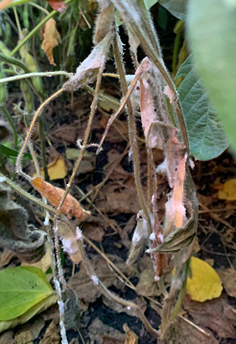 |
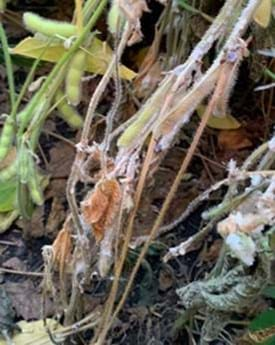 |
If you have fields that have a history of White Mold (SWM) that are in soybeans this year and are looking at applying control measures, many fungicides such as Approach, recommend applications at R1 followed by another application at R3. This tends to make sense in that most fungicides do not move into new growth, and an additional application at R3 would provide supplementary coverage to new flowers and vegetative growth on the plant.
If you have any questions regarding this or other agronomic topics, contact your Dairyland Seed Agronomist.
Leafhopper Scouting
|
Watch second crop alfalfa for leafhopper presence and damage. Potato Leafhoppers ‘pierce and suck’ the main stem of alfalfa leaflets, leaving the typical V-shaped chlorotic leaflet tips that eventually lead to necrosis (see photo). This damage can hurt yield and quality, so it is best to anticipate and detect issues prior to damage. Standard scouting recommendations call for the use of a 15” sweep net starting ~1 week after harvest. Conduct 5 sets of 20 sweeps in various areas of the field (100 total sweeps). Calculate the number of hoppers captured per sweep. The University of Wisconsin recommends cutting or treating fields that exceed the thresholds in Table 1. If you decide to cut early instead of spraying insecticide, watch the regrowth closely! |
|
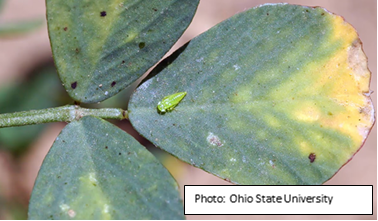 |
Table 1. Potato Leafhopper thresholds for alfalfa (University of Wisconsin)
|
Alfalfa Height (inches) |
Economic Threshold (hoppers/sweep) |
|
3 |
0.2 |
|
6 |
0.5 |
|
8-11 |
1.0 |
|
12+ |
2.0 |
Corteva Technology Use Agreements
All growers with orders for any Corteva Agriscience brand seed product, regardless of crop or trait (including non-GM products) need to have a signed Corteva Technology Use Agreement in place by September 1. Growers should sign the Corteva Technology Use Agreement electronically at www.agcelerate.com. Signing electronically is preferable, however, paper copies are available at www.traitstewardship.com.
 |
 |
 |
 |
 |
| Brian Weller Western Region 507.456.3034 |
Dan Ritter Central Region 219.863.0583 |
Branden Furseth Northern Region 608.513.4265 |
Rod King Eastern Region 574.596.6721 |
Terry Jones Eastern Region 419.630.3115 |

